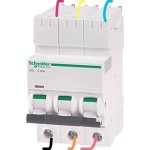Mas01
Member
I need to send a signal to our PLC (Mitsubishi Q series) which is TRUE when there's current flowing and FALSE otherwise. The thing is, the cable in question is high current and I am trying to avoid any electrical changes since a contractor installed the electrical control panel and circuitry. I don't want to invalidate any warranty or something like that, and there's some huge earthbars in there that scare me.
Is there a non-intrusive way to detect current flow which I can route back to the PLC. All I need is a lamp on the PLC screen to indicate power is on.
This is needed on the PLC because sometimes the circuit breaker (see picture) trips to the OFF position when we don't expect it to. Thanks

Is there a non-intrusive way to detect current flow which I can route back to the PLC. All I need is a lamp on the PLC screen to indicate power is on.
This is needed on the PLC because sometimes the circuit breaker (see picture) trips to the OFF position when we don't expect it to. Thanks

Last edited:





